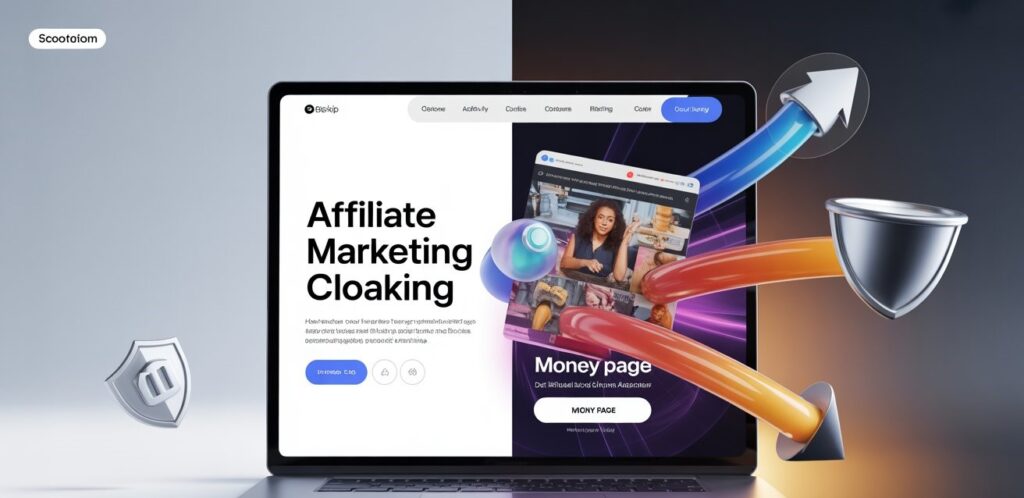
Introduction
If you’ve ever woken up to find your ad account banned or your best campaign ripped by a spy tool, you know the pain. That’s the reality of affiliate marketing. Things move fast, platforms get stricter every year, and the margin for error is tiny. That’s why cloaking in affiliate marketing exists. Not as a gimmick, but as a way to keep campaigns alive long enough to actually scale. Without it, you’re running unprotected into battle.
What Cloaking Really Means
Cloaking isn’t complicated. It’s just showing different things to different people.
- Reviewers and bots get the clean, “nothing to see here” version.
- Real buyers get the page that sells.
That’s all there is to it. You don’t need a tech background to understand it. You just need to know it works.
Why Affiliates Bother With Cloaking
Here’s the truth: running without cloaking is like playing whack-a-mole. Ads go down. Accounts vanish. Competitors steal your funnel before you’ve even scaled it.
Cloaking solves a few big headaches:
- Prevents reviewers from killing campaigns mid-flight.
- Filters out junk traffic so you’re not wasting clicks.
- Hides your landing pages from prying eyes.
- Lets you run harder offers without everything collapsing.
If you’ve been forced to scale back your creatives just to pass review, you already know why cloaking matters.
What You Actually Gain from Cloaking
Affiliates don’t use cloaking for fun. They use it because it pays.
- Protection – Your money pages stay hidden.
- ROI boost – Only real buyers see what matters.
- Traffic control – Filter by GEO, device, referrer, even IP ranges.
- Scaling power – You’re not rebuilding from scratch after every ban.
- Secrecy – Competitors can’t rip what they can’t see.
That’s the practical side of cloaking in affiliate marketing.
How the Flow Works
Picture it step by step:
- Someone clicks your ad.
- The cloaker checks the visitor.
- Reviewer? Bot? They hit the white page.
- Real human with a wallet? Straight to the money page.
It runs quietly. No fuss.
Cloaking vs. Just Running Clean
| Aspect | No Cloak | With Cloak |
|---|---|---|
| Ad Approvals | Constant roadblocks | Ads last longer |
| Traffic | Mixed, lots of waste | Filtered and valuable |
| Conversions | Lower, generic funnels | Higher, tailored pages |
| Campaign Security | Easy to copy | Hidden from spies |
How to Cloak the Right Way
Some quick advice from affiliates who’ve been there:
- Don’t cheap out on the tool. A weak cloaker is worse than none.
- Use filters wisely—GEO, device, referrer. Don’t open the doors to everyone.
- Rotate your white pages so they don’t look suspicious.
- Always test. Don’t just set it up and forget it.
- Think big picture. Cloaking isn’t a one-off trick; it’s part of scaling smart.
Where Cloaking is Heading
Ad platforms aren’t getting friendlier. Every update makes it harder for affiliates to survive without some kind of protection. That’s why cloakers are leveling up too.
Now you’ve got cloakers offering:
- Real-time reviewer detection.
- AI-based traffic filters.
- Multi-network support.
- Dashboards simple enough that even new affiliates can manage.
Cloaking is no longer optional. It’s table stakes.
Trafficshield Case Studies:
How a Facebook Affiliate Campaign Ran for 30 Days Without Getting Banned Using TrafficShield
Scaling Offers Globally: How an International Affiliate Used Trafficshield to Pass Local Ad Review Filters
Conclusion
Cloaking in affiliate marketing is about survival. It’s about keeping your campaigns live long enough to actually profit, protecting your funnels, and scaling without constant setbacks.
The right cloaker—like TrafficShield—gives you that edge. Run smarter, safer and longer.
👉 Ready to stop losing campaigns overnight? Try Trafficshield Now
FAQs
1. Is cloaking allowed in affiliate marketing?
Cloaking is a tool. Affiliates use it to filter traffic and protect campaigns. The “allowed” part depends on how you use it.
2. Can it really improve ROI?
Yes. Because the right audience sees the right page. Bots and reviewers don’t waste your clicks.
3. Do all affiliates need it?
If you’re pushing volume or running tougher offers, cloaking makes life easier.
4. White page vs. money page—what’s the difference?
- White page: Clean, safe, shown to reviewers.
- Money page: The real funnel designed to sell.
5. Which cloaker works best?
Serious affiliates use TrafficShield. Reliable filters, campaign protection, and room to scale.




